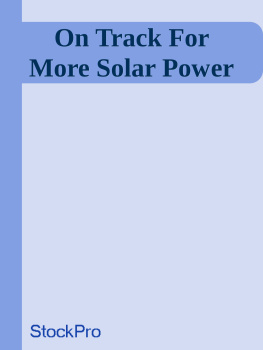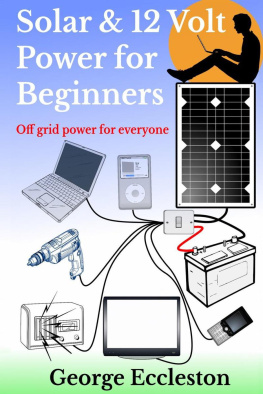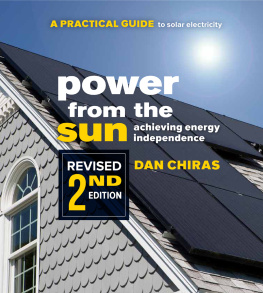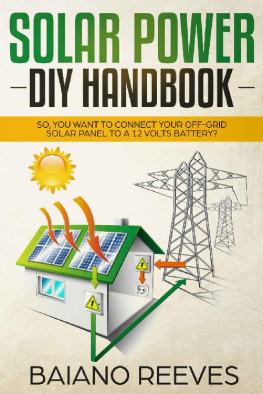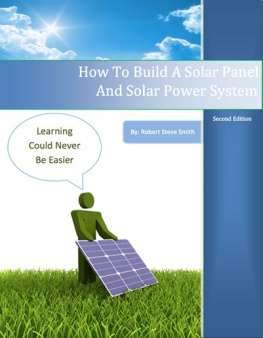StockPro - On Track For More Solar Power
Here you can read online StockPro - On Track For More Solar Power full text of the book (entire story) in english for free. Download pdf and epub, get meaning, cover and reviews about this ebook. year: 0, genre: Science. Description of the work, (preface) as well as reviews are available. Best literature library LitArk.com created for fans of good reading and offers a wide selection of genres:
Romance novel
Science fiction
Adventure
Detective
Science
History
Home and family
Prose
Art
Politics
Computer
Non-fiction
Religion
Business
Children
Humor
Choose a favorite category and find really read worthwhile books. Enjoy immersion in the world of imagination, feel the emotions of the characters or learn something new for yourself, make an fascinating discovery.
On Track For More Solar Power: summary, description and annotation
We offer to read an annotation, description, summary or preface (depends on what the author of the book "On Track For More Solar Power" wrote himself). If you haven't found the necessary information about the book — write in the comments, we will try to find it.
On Track For More Solar Power — read online for free the complete book (whole text) full work
Below is the text of the book, divided by pages. System saving the place of the last page read, allows you to conveniently read the book "On Track For More Solar Power" online for free, without having to search again every time where you left off. Put a bookmark, and you can go to the page where you finished reading at any time.
Font size:
Interval:
Bookmark:
Written by StockPro. Oct. 2015.
Introduction:
Function: More solar power without getting blown away.
I am what would be considered by many an eccentric old fart and in many ways I am - old definitely. Ive had wide experience, have kept up and basically understand current engineering, science and technology. I tend to research every thing to the N-th degree, both the good and bad. People are forever contacting me asking questions, I had several info. text files, so I decided to correlate them into a couple of eBooks, this is the first.
This article was written for the Southern hemisphere. For Northern hemisphere reverse N-S and the summer winter solstices.
It was more difficult and time consuming than I first realized, one has to really get ones thoughts in order. With country rock playing in the background, I fiddled around, much more stimulating than watching mindless crap on TV.
Cover design by: Jubilee Graphics.
Sponsored by: Organic Y2K bug spray.
Free - Just to try and help people and promote solar energy.
Trash-Tracker, Australia. stockpro@bigpond.net.au
I wont give my name or exactly where I live, Ill just say Qld. a bit North of the Tropic of Capricorn. I dont want every green half-baked technical loony in the area banging on my door, but I will respond to plausible eMails.
I wonder if the Australian governments will ban coal mining before we all fry or melt as the consequence of global warming?
I think things are well past the tipping points, its now not a question of how bad things will get, but just how fast!
I also wonder if at some point in the future, people who are currently still pushing and advocating the use of fossil fuels, coal in particular, will get prosecuted for crimes against humanity? Climate Criminals!
Note: All books are written in eco-sensitive fully recyclable digital ink.
By StockPro.
This article is a chat about getting the maximum yield out of your solar PV. panels over the longest period of time each day to maximize the overall longer term power production. Its aimed at people who like mucking-about and making things!
It should give a reasonable handyperson, or farmer enough information to build a strong plausible solar tracker at minimum cost, preferably out of junk, scrap metal and recycled parts. You have to buy solar PV. panels, charge controller, grid-tied inverter, batteries etc. but you can build a plausible tracker, it can be as rough as you like as long as its strong and you get the GEOMETRY right! (ahh! geometry!).
Ive spent the last six months scouring the web and reading everything I could find about solar trackers, there are several YouTube clips by Brian White that are interesting and I found a very early obscure research paper on an Indian university web site about equatorial solar trackers and a picture of what looked like a very large demo. setup. I found just one American manufacturer who makes a functional equatorial tracker but its up on a central pole type mount and would be just as vulnerable and prone to storm damage as all the other more conventional trackers.
To get the maximum power production, your panels need to directly face the Sun all the time and present the largest surface area at right angles, end of story, no discussion! Thats when theres direct sunlight, when theres no direct sunlight, just haze, the light is scattered, bouncing around and coming from all directions, the panels should be parked horizontal and pointing straight up.
To keep the panels pointing at the Sun they need both their E-W. and the N-S. axiss to track and follow the Sun.
There are two types of trackers that will do this, the myriad of expensive complicated fully powered two axis trackers with light sensors and fancy control electronics etc. Then there are relatively simple equatorial trackers with powered daily E-W. tracking and manual N-S. seasonal adjustment about once a fortnight. Its the equatorial trackers Ill talk about.
Astronomical telescopes have used equatorial tracking for hundreds of years, but the solar industry doesnt seem to understand and ignores them. I dont know if its because I can astro-navigate, understand marine compass gimbals, have setup TV. satellite dishes, and have a good understanding of armillary spheres (I was thinking of making them and sundials at one stage) I could visualize the benefits. I was sitting here looking out through my sunrooms louvers (they're heavy industrial glass louvers) when I realized that was the way to adjust the panels. This will make a very strong simple tracker, suitable for the tropics and cyclone areas, after all the Sun is a primary star. While I don't consider I've actually invented anything, I've probably put things together slightly differently and writen an explanatory booklet hopefully anyone can understand.
There are many types of trackers, but forget about satellite trackers, tracking radar, missile launchers, search-lights etc., most of the stuff on YouTube and anything that rotates around a vertical pole isnt exactly a good idea either. One of the problems is to get the tracker to actually move slowly enough; this is done by extremely low worm-drive gearing or switching the drive on and off. But the key to everything is the trackers geometry and a set up thats specific to each sites latitude.
Firstly the Sun is very large and very far away, all the direct light rays hitting the Earth are coming in parallel, its like the Earth is a tennis ball in the beam of a very large powerful spotlight two miles away, solar energy is indirect nuclear fusion power and its free. The Sun doesnt move, its the Earth that spins, wobbles and orbits the Sun, what we see on the planet is all relative motion. The daily spin axis of the Earth is angled at about 23.5 deg. to the annual orbital plane, thats why the seasons change, theres lots of good animated explanations on the Internet. The apparent motion of the Sun each year is from the Equator, North to the Tropic of Cancer, then back crossing the Equator and on South to the Tropic of Capricorn, then back up to the Equator again to start another annual seasonal cycle. When the sun crosses the equator its called an Equinox and when it reaches either of the two Tropics its called a Solstice. The summer Southern Solstice is around 22 Dec. and Northern around 21 Jun. Solar noon is when the Earths rotation lines up the Sun at a right angle to your line of longitude. So if you were standing on the Equator at solar noon on an Equinox the Sun would be directly vertically over your head for a short time, the same thing would happen if you were standing on the Tropic of Capricorn at solar noon on the Southern Solstice. If you live between the Tropics the Sun shines from both the North and South over the year, if you live South of the Tropic of Capricorn the Sun only shines from the North.
Now! lets just suppose you lived right on the Equator, the apparent seasonal movement of the sun would be North 23.5 deg. and South 23.5 deg., or a combined angle of 47deg. Now were getting all a bit mathematical and techtrickery here. The Sun moves North 23.5deg. then back 23.5deg. then South 23.5deg. then back 23.5deg., so thats an annual movement of 94deg. So divide 94deg. by 365 days and you get approximately 0.25deg per day, it does slightly speed up and slow down but of no concern to our endeavors.
The Earth rotates through 360deg. every 24 hours, divide 360deg. by 24 hours. and you get 15deg. per hour, divide 15deg. by 60 minutes and you get 0.25deg per minute. Wow - thats all the mathematics done!
If you set up a horizontal pivot on the Equator aligned true N-S, to pivot E-W. it would need powered tracking for each day, but the individual solar panels would only need manual seasonal N-S adjustment about once a fortnight. This is an Equatorial Tracker, the main primary pivot and the axis of the Earth are parallel and the rotation is at exactly the same speed, so its a time based system and can be controlled with a simple clock timer. There are no light sensors, its known where the sun is at a particular time and rotation angle, thats where the panels point, no matter what.
Font size:
Interval:
Bookmark:
Similar books «On Track For More Solar Power»
Look at similar books to On Track For More Solar Power. We have selected literature similar in name and meaning in the hope of providing readers with more options to find new, interesting, not yet read works.
Discussion, reviews of the book On Track For More Solar Power and just readers' own opinions. Leave your comments, write what you think about the work, its meaning or the main characters. Specify what exactly you liked and what you didn't like, and why you think so.

